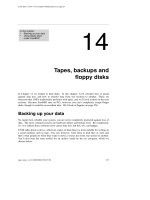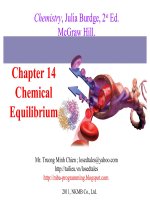chapter 14 partb
Bạn đang xem bản rút gọn của tài liệu. Xem và tải ngay bản đầy đủ của tài liệu tại đây (2.09 MB, 45 trang )
14-2 How Are the Earth’s Rocks
Recycled?
Concept 14-2 The three major types of rocks found
in the earth’s crust—sedimentary, igneous, and
metamorphic—are recycled very slowly by the
process of erosion, melting, and metamorphism.
There Are Three Major Types of Rocks (1)
Earth’s crust
• Composed of minerals and rocks
Three broad classes of rocks, based on formation
1.Sedimentary (made of sediments- clastic
-cemented and compacted and chemicalmade from dissolved minerals like
limestone and rock salt)
• Sandstone and shale (compacted sediments)
• Dolomite and limestone (compacted shells and
skeletons)
• Lignite and bituminous coal (compacted plant
remains)
There Are Three Major Types of Rocks (2)
2. Igneous – forms the bulk of earth’s crust
•
•
•
•
Granite (formed underground)
Pumice
Obsidian
Basalt
3. Metamorphic –formed by heat and
pressure
•
•
•
•
Anthracite from coal
Slate from shale
Marble from limestone
Gneiss from granite
The Earth’s Rocks Are Recycled
Very Slowly
Rock cycle
The slowest of the earth’s cyclic processes
Dolomite (see the shells)and a cave of limestone
The Rock Cycle
14-3 What Are Mineral Resources, and
what are their Environmental Effects?
Concept 14-3A Some naturally occurring materials
in the earth’s crust can be extracted and made into
useful products in processes that provide economic
benefits and jobs.
Concept 14-3B Extracting and using mineral
resources can disturb the land, erode soils, produce
large amounts of solid waste, and pollute the air,
water, and soil.
We Use a Variety of Nonrenewable
Mineral Resources
Mineral resource (concentration of a naturally
occurring material)
• Fossil fuels (coal)
• Metallic minerals (Al, Fe, Cu)
• Nonmetallic minerals (sand, gravel)
Ore – contains enough of the mineral to be profitable
to mine
• High-grade ore
• Low-grade ore
Mineral Categories
1) Rock-forming minerals
Most common minerals in the Earth’s crust, e.g.
olivine, pyroxene, mica, feldspar, quartz, calcite and
dolomite.
2) Accessory minerals
Minerals that are common but usually are found only
in small amounts, e.g. chlorite, garnet, hematite,
limonite, magnetite, and pyrite.
3) Gems
A mineral that is prized primarily for its beauty.
(Although some gems, like diamonds are also used
industrially), e.g. diamond, emerald, ruby, and
sapphire.
Mineral Categories (cont.)
4)
5)
Ore minerals
Minerals from which metals or other elements can
be profitably recovered, e.g. native gold, native
silver, chalcopyrite, galena, and sphalerite.
Industrial minerals
Minerals are industrially important, but are mined
for purposes other than the extraction of metals,
e.g. halite for table salt.
QUARTZ –SiO2
Quartz is the most common
mineral on
Earth. It is found in nearly every geological environment
and is at least a component of almost every rock type. It
is also the most varied in terms of varieties, colors and
forms.
Uses: silica for glass, electrical components, optical
lenses, abrasives,
gemstones, ornamental
stone, building stone, etc.
Mineral tests and observations
Color is as variable as the spectrum, but clear quartz is by far the most
common color
Luster is vitreous (glassy)
Reflection of light: Crystals are transparent to translucent
Cleavage -none
Fracture is conchoidal.
(calcite with
Hardness is 7
rhombohedral cleavage)
Specific Gravity is 2.65
Streak is white.
A metalloid and semiconductor
(Conchoidal fracture of quartz)
fireworks, computers, transistors, pottery,
contacts, breast implants, solar cells, glass,
Mineral Use Has Advantages and
Disadvantages
Advantages of the processes of mining and
converting minerals into useful products
Generates income, provides revenue for states and
employment
Disadvantages – energy intensive and can disturb
the land, erode soil and produce solid waste and
pollution
Surface
mining
Metal ore
Separation
of ore from
gangue
Smelting
Melting
metal
Conversion
to product
Discarding
of product
Recycling
Stepped Art
Fig. 14-14, p. 355
NATURAL CAPITAL
DEGRADATION
Extracting, Processing, and Using Nonrenewable Mineral and Energy Resources
Steps
Environmental Effects
Mining
Exploration,
extraction
Processing
Transportation,
purification,
manufacturing
Use
Transportation or
transmission to
individual user, eventual
use, and discarding
Disturbed land; mining
accidents; health
hazards; mine waste
dumping; oil spills and
blowouts; noise;
ugliness; heat
Solid wastes;
radioactive material; air,
water, and soil pollution;
noise; safety and health
hazards; ugliness; heat
Noise; ugliness; thermal
water pollution; pollution
of air, water, and soil;
solid and radioactive
wastes; safety and
health hazards; heat
Fig. 14-15, p. 356
There
Are
Several
to mineral/rock
Remove
Surface
mining90% ofWays
nonmetal
resources
and 60% of(1)
coal
Mineral
Deposits
• Shallow deposits removed- overburden, spoils,
tailings(material dredged from streams)
1. Open Pit
2. Strip mining- (when the ore is in horizontal beds)
3. Area strip mining- (flat land)
4. Contour strip mining- (mostly used to mine coal
from mountains)
5. Mountain top removal (Appalachian Mts)explosives
Subsurface mining
• Deep deposits removed
Natural Capital Degradation: Open-Pit
Mine in Western Australia
Undisturbed land
Overburden
Hig
h wa
ll
Coa
ls
Ove eam
rb u
rde
n
Pit
Bench
Co
al s
e
am
Spoil banks
Fig. 14-17, p. 357
Natural Capital Degradation:
Mountaintop Coal Mining in West
Virginia, U.S.
Mining Has Harmful Environmental
Effects (1)
Scarring and disruption of the land surface
• E.g., spoils banks
Loss of rivers and streams
Subsidence
•
road built over old mine shafts
created a sinkhole
Mining Has Harmful Environmental
Effects (2)
Major pollution of water and air
Effect on aquatic life
Large amounts of solid waste
EPA cites that mining has polluted 40% of western
watersheds.
In US, mining produces more toxic emissions than
any other industry
Banks of Waste or Spoils Created by
Coal Area Strip Mining in Colorado, U.S.
Illegal Gold Mine
Ecological Restoration of a Mining Site
in New Jersey, U.S.
Removing Metals from Ores Has Harmful
Environmental Effects (1)
Ore extracted by mining
• Ore mineral- a rock deposit that contains
enough mineral to make it feasible to mine
• Gangue- commercially worthless material
that is mixed in with the ore
• Smelting – obtaining ore by heating at high
temperatures in an enclosed furnace
Water pollution- ARD (acid rock drainage) --when
sulfur containing rocks are exposed to air and water
and create sulfuric acid
Removing Meals from Ores Has Harmful
Environmental Effects (2)
Liquid and solid hazardous wastes produced
Use of cyanide salt to extract gold from its ore
• Summitville gold mine: Colorado, U.S.









